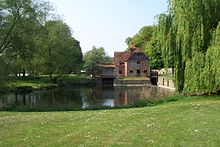The first album which going to tell you is the Black Sabbath first album and the most famous album the one that brought heavy metal to the public’s attention.
Black Sabbath debuted this full album in February 13, 1970 by Vertigo Records in the United Kingdom and in June 1st, of this same year by Warner Bros. Records in the United States. This album has been the true Heavy Metal ever since.
This first track about this album is titled of ‘Black Sabbath’ and has been refered to as the first Doom Metal song.
Black Sabbath received in the first moment, negative reviews from critics upon its release, but was a commercial success reaching number eight on the UK Albums Charts and number 23 on the US Billboard Top LPs chart.
After that, Black Sabbath became a reference and influence in heavy metal worldwide. It is included in Robert Dimery’s 2005 musical reference book 1001 Albums You Must Hear Before You Die.
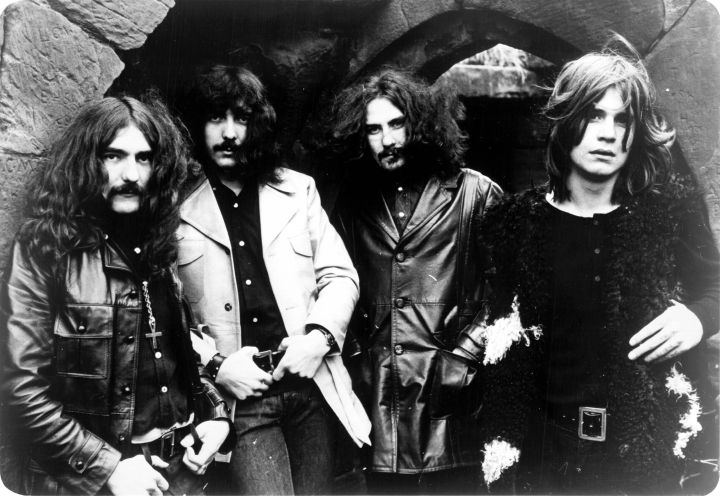
– Members from Black Sabbath in 1970:
- Ozzy Osbourne – lead vocals, harmonica on “The Wizard”, tambourine;
- Tony Iommi – guitar;
- Geezer Butler – bass;
- Bill Ward – drums;
– Production:
- Rodger Bain – production, Jew’s harp on “Sleeping Village”;
- Tom Allom – engineering;
- Barry Sheffield – engineering;
- Marcus Keef – graphic design, photography.
Tracklist:
– European edition:
| No. | Title | Length |
|---|---|---|
| 1. | “Black Sabbath” | 6:20 |
| 2. | “The Wizard” | 4:24 |
| 3. | “Behind the Wall of Sleep” | 3:37 |
| 4. | “N.I.B.” | 6:08 |
| No. | Title | Writer(s) | Length |
|---|---|---|---|
| 5. | “Evil Woman” | Larry Weigand, Dick Weigand, David Wagner | 3:25 |
| 6. | “Sleeping Village” | 3:46 | |
| 7. | “Warning” | Aynsley Dunbar, Alex Dmochowski, Victor Hickling, John Moorshead | 10:28 |
| Total length: | 38:08 | ||
– 1996 CD Reissue Bonus Track | ||
| No. | Title | Length |
|---|---|---|
| 8. | “Wicked World” | 4:47 |
| Total length: | 42:55 | |
| – 2009 Deluxe Edition of European Version, Disc Two | ||
| No. | Title | Length |
|---|---|---|
| 1. | “Wicked World” (single B-side, TF1067) | 4:44 |
| 2. | “Black Sabbath” (studio outtake) | 6:22 |
| 3. | “Black Sabbath” (Instrumental) | 6:13 |
| 4. | “The Wizard” (studio outtake) | 4:46 |
| 5. | “Behind the Wall of Sleep” (studio outtake) | 3:41 |
| 6. | “N.I.B.” (instrumental[nb 2]) | 6:08 |
| 7. | “Evil Woman” (alternative version) | 3:47 |
| 8. | “Sleeping Village” (intro) | 3:45 |
| 9. | “Warning” (part 1) | 6:58 |
| Total length: | 46:24 | |
– North American edition:
| – Side A, Standard Edition: | ||
| No. | Title | Length |
|---|---|---|
| 1. | “Black Sabbath” | 6:20 |
| 2. | “The Wizard” | 4:22 |
| 3. | “Wasp / Behind the Wall of Sleep / Bassically / N.I.B.” | 9:44 |
| – Side B: | |||
| No. | Title | Writer(s) | Length |
|---|---|---|---|
| 4. | “Wicked World” | 4:47 | |
| 5. | “A Bit of Finger / Sleeping Village / Warning” | Iommi, Butler, Ward, Osbourne / Dunbar, Dmochowski, Hickling, Moorshead | 14:15 |
| Total length: | 39:28 | ||
| – 2004 Reissue Bonus Track: | ||
| No. | Title | Length |
|---|---|---|
| 6. | “Evil Woman” (L. Weigand, D. Weigand, Wagner) | 3:25 |
| Total length: | 42:53 | |
| – 2016 Deluxe Edition of North American Version, Disc Two: | ||
| No. | Title | Length |
|---|---|---|
| 1. | “Evil Woman” | 3:25 |
| 2. | “Black Sabbath” (studio outtake) | 6:22 |
| 3. | “Black Sabbath” (Instrumental) | 6:13 |
| 4. | “The Wizard” (studio outtake) | 4:46 |
| 5. | “Behind the Wall of Sleep” (studio outtake) | 3:41 |
| 6. | “N.I.B.” (instrumental) | 6:08 |
| 7. | “Evil Woman” (alternative version) | 3:47 |
| 8. | “Sleeping Village” (intro) | 3:45 |
| 9. | “Warning” (Part 1) | 6:58 |
| Total length: | 45:05 | |
- The original North American Warner Bros. Records pressings of Black Sabbath list incorrect running times for “Wicked World” and the “Warning” medley (4:30 and 14:32, respectively), and also credit the album’s original songs using the band members’ given names (Anthony Iommi, John Osbourne, Terence Butler, and William Ward). The Castle Communications edition of 1986 also featured a live version of “Tomorrow’s Dream” as a bonus track.
- Disc two of the Deluxe Editions contains “N.I.B. (studio out-take)” with vocals, that was incorrectly listed as “N.I.B. (instrumental)”.
Recording:
According to Black Sabbath’s guitarist and founding member Tony Iommi, the group’s debut album was recorded in a single twelve-hour session on 16 October 1969. Iommi said: “We just went in the studio and did it in a day, we played our live set and that was it. We actually thought a whole day was quite a long time, then off we went the next day to play for £20 in Switzerland.” A side from the bells, thunder and rain sound effects added to the beginning of the opening track and the double-tracked guitar solos on “N.I.B.” and “Sleeping Village”, there were virtually no overdubs added to the album. Iommi recalls recording live: “We thought, ‘We have two days to do it and one of the days is mixing.’ So we played live. Ozzy was singing at the same time, we just put him in a separate booth and off we went. We never had a second run of most of the stuff.”
The key to the band’s new sound on the album was Iommi’s distinctive playing style that he developed after an accident at a sheet metal factory where he was working at the age of 17 in which the tips of the middle fingers of his fretting hand were severed. Iommi created a pair of false fingertips using plastic from a dish detergent bottle and tuned the strings on his guitar down to make it easier for him to bend the strings, creating a massive, heavy sound. “I’d play a load of chords and I’d have to play fifths because I couldn’t play fourths because of my fingers,” Iommi explained to Phil Alexander in Mojo in 2013. “That helped me develop my style of playing, bending the strings and hitting the open string at the same time just to make the sound wilder.” In the same article bassist Geezer Butler added, “Back then the bass player was supposed to do all these melodic runs, but I didn’t know how to do that because I’d been a guitarist, so all I did was follow Tony’s riff. That made the sound heavier.”
Iommi began recording the album with a white Fender Stratocaster, his guitar of choice at the time, but a malfunctioning pickup forced him to finish recording with a Gibson SG, a guitar he had recently purchased as a backup but had “never really played”. The SG was a right-handed model which the left-handed Iommi played upside down. Soon after recording the album, he met a right-handed guitarist who was playing a left-handed SG upside down, and the two agreed to swap guitars; this is the SG that Iommi modified and later “put out to pasture” at the ‘Hard Rock Cafe’.
Black Sabbath vocals Ozzy Osbourne has always spoken fondly of the recording of the band’s debut album, stating in his autobiography ‘I Am Ozzy‘, “Once we’d finished, we spent a couple of hours double-tracking some of the guitar and vocals, and that was that. Done. We were in the pub in time for last orders. It can’t have taken any longer than twelve hours in total. That’s how albums should be made, in my opinion.” Drummer Bill Ward agrees, telling Guitar World in 2001, “I think the first album is just absolutely incredible. It’s naïve, and there’s an absolute sense of unity – it’s not contrived in any way, shape or form. We weren’t old enough to be clever. I love it all, including the mistakes!” In an interview for the Classic Albums series in 2010 Butler added, “It was literally live in the studio. I mean, (producer) Rodger Bain, I think he’s a genius the way he captured the band in such a short time.” In his autobiography Iron Man: My Journey Through Heaven & Hell with Black Sabbath, Iommi plays down the producer’s role, insisting, “We didn’t choose to work with Rodger Bain, he was chosen for us… He was good to have around, but we didn’t really get a lot of advice from him. He maybe suggested a couple of things, but the songs were already fairly structured and sorted.”
– Genre of Black Sabbath in the ‘Black Sabbath‘ album:
Some critics tell about a Hard Blues – Rock, some critics tell about the birth of Heavy Metal;
In opinion, the album “transcends its clear roots in blues-rock and psychedelia to become something more”. Ascribes its “sonic ugliness” as a reflection of “the bleak industrial nightmare” of the group’s hometown, Birmingham, England.
- In the side A: the tracks are Heavy Metal, including Evil, Paganism, Occultism, “as filtered through horror films and the writings of J. R. R. Tolkien, H. P. Lovecraft, and Dennis Wheatley.”
- And, in the side B: the tracks are as “given over to loose blues-rock jamming learned through” the English rock band Cream”.
Others critics said which “the Black Sabbath has a reference of the Jazz, Blues, Rock” and carry on the first elements from Stoner Rock and Doom Metal.
But, “The debut Black Sabbath album of 1970 was a watershed moment in heavy rock, but it was part of a larger trend of artists, producers, and engineers already moving towards the sound we now call hard rock and heavy metal.”
– Music & Lyrics:
Black Sabbath‘s music and lyrics were quite dark for the time. The opening track is based almost entirely on a tritone interval played at slow time on the electric guitar. In the 2010 Classic Albums documentary on the making of the band’s second album Paranoid, bassist Geezer Butler claims the riff was inspired by “Mars, the Bringer of War”, a movement in Gustav Holst’s The Planets. Iommi reinterpreted the riff slightly and redefined the band’s direction. Ward told Classic Albums, “When Oz sang ‘What is this that stands before me?’ it became completely different…this was a different lyric now, this was a different feel. I was playing drums to the words.” The song’s lyrics concern a “figure in black” which Geezer Butler claims to have seen after waking up from a nightmare. In the liner notes to the band’s 1998 live album Reunion the bassist remembers:
I’d been raised a Catholic so I totally believed in the Devil. There was a weekly magazine called Man, Myth and Magic that I started reading which was all about Satan and stuff. That and books by Aleister Crowley and Dennis Wheatley, especially The Devil Rides Out … I’d moved into this flat I’d painted black with inverted crosses everywhere. Ozzy gave me this 16th Century book about magic that he’d stolen from somewhere. I put it in the airing cupboard because I wasn’t sure about it. Later that night I woke up and saw this black shadow at the end of the bed. It was a horrible presence that frightened the life out of me! I ran to the airing cupboard to throw the book out, but the book had disappeared. After that I gave up all that stuff. It scared me shitless.
Similarly, the lyrics of the song “N.I.B.” are written from the point of view of Lucifer, who falls in love with a human woman and “becomes a better person” according to lyricist Butler. Contrary to popular belief, the name of that song is not an abbreviation for “Nativity in Black;” according to Osbourne’s autobiography it is merely a reference to drummer Bill Ward’s pointed goatee at the time, which was shaped as a fountain pen-nib. The lyrics of two other songs on the album were written about stories with mythological themes. “Behind the Wall of Sleep” is a reference to the H. P. Lovecraft short story “Beyond the Wall of Sleep,” while “The Wizard” was inspired by the character of Gandalf from The Hobbit and The Lord of the Rings. The latter includes harmonica playing by Osbourne. The band also recorded a cover of “Evil Woman”, a song that had been an American hit for the band Crow. In his autobiography, Iommi admits the band reluctantly agreed to do the song at the behest of their manager Jim Simpson, who insisted they record something commercial.
– Artwork:
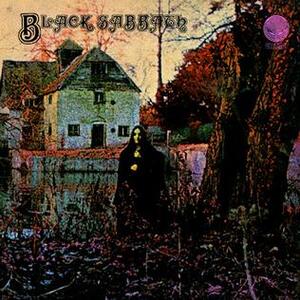
The cover photograph was shot at Mapledurham Watermill, situated on the River Thames in Oxfordshire, England, by photographer Keith Stuart Macmillan (credited as Keef), who was in charge of the overall design. Standing in front of the watermill is a figure dressed in a black cloak, portrayed by model Louisa Livingstone, whose identity was not widely known until 2020. “I’m sure (McMillan) said it was for Black Sabbath, but I don’t know if that meant anything much to me at the time,” Livingstone recalled, adding that it had been “freezing cold” during the shoot. “I had to get up at about 4 o’clock in the morning. Keith was rushing around with dry ice, throwing it into the water. It didn’t seem to be working very well, so he ended up using a smoke machine,” said the model.

According to McMillan, Livingstone was wearing nothing underneath the black cloak, and some experimentation was done involving some “slightly more risqué” photographs taken at the session. “We decided none of that worked,” McMillan said. “Any kind of sexuality took away from the more foreboding mood. But she was a terrific model. She had amazing courage and understanding of what I was trying to do.”
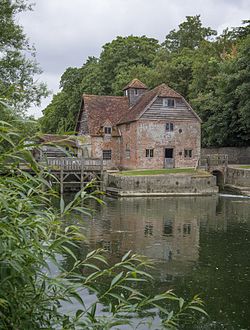
The inner gatefold sleeve of the original release featured an inverted cross containing a poem written by Roger Brown, McMillan’s photography assistant. The band were reportedly upset when they discovered this, as it fuelled allegations that they were satanists or occultists; however, in Osbourne’s memoirs, he says that to the best of his knowledge nobody was upset with the inclusion. Iommi’s recollection is somewhat different: “Suddenly we had all these crazy people turning up at shows,” he told Mojo magazine in 2013. “I think Alex Sanders (high priest of the Wiccan religion) turned up at a gig once. It was all quite strange, really.” The liner notes to the 1998 Reunion album state “Unbeknownst to the band, Black Sabbath was launched in the U.S. with a party with the head of the Church of Satan, Anton LaVey, presiding over the proceedings… All of a sudden Sabbath were Satan’s Right Hand Men.”
- In the years since the iconic cover photo was shot, Livingstone has released electronic music under the name Indreba.
In 1989, Kerrang! ranked Black Sabbath number 31 on their “100 Greatest Heavy Metal Albums of All Time”. In 1994, it was ranked number 12 in Colin Larkin‘s Top 50 Heavy Metal Albums. Larkin praised the album’s “crushing atmosphere of doom”, which he described as “intense and relentless”. In 2000, Q magazine included Black Sabbath in their list of the “Best Metal Albums of All Time”, stating: “[This album] was to prove so influential it remains a template for metal bands three decades on.” In 2003, it was ranked number 241 on Rolling Stone magazine’s list of the 500 Greatest Albums of All Time, 243 in a 2012 revised list, and 355 in a 2020 revised list. Rolling Stone ranked Black Sabbath number 44 in their list of the ‘100 Best Debut Albums of All Time’, describing the title track as the song that “would define the sound of a thousand bands”. Additionally, in 2017, the magazine ranked it 5th on their list of “100 Greatest Metal Albums of All Time”. The album was also included in the book 1001 Albums You Must Hear Before You Die.
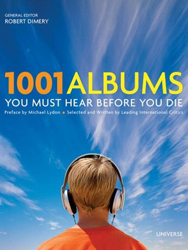
Charts:
| Chart (1970) | Peak position |
|---|---|
| Australian Albums (Kent Music Report) | 8 |
| Canada Top Albums/CDs (RPM) | 29 |
| Dutch Albums (Album Top 100) | 6 |
| Finnish Albums (The Official Finnish Charts) | 13 |
| French Albums (SNEP) | 10 |
| German Albums (Offizielle Top 100) | 8 |
| UK Albums (OCC) | 8 |
| US Billboard 200 | 23 |
| Chart (2022) | Peak position |
|---|---|
| Scottish Albums (OCC) | 24 |
| UK Independent Albums (OCC) | 11 |
| UK Rock & Metal Albums (OCC) | 3 |
Certifications
| Region | Certification | Certified units/sales |
|---|---|---|
| Canada (Music Canada) | Gold | 50,000^ |
| United Kingdom (BPI) 2009 deluxe edition | Gold | 100,000^ |
| United States (RIAA) | Platinum | 1,000,000^ |


